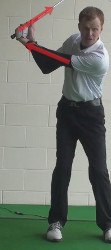
In golf, the term “cupped wrist” refers to a specific wrist position during the golf swing where the back of the lead hand (left hand for right-handed golfers) has an exaggerated upward bend, creating a concave shape resembling a cup. This wrist position is also known as a “flipped” or “scooped” wrist.
Here are a few key points about a cupped wrist in golf:
- Lead Hand: The cupped wrist primarily relates to the lead hand, which is the top hand on the golf club for right-handed golfers. The back of the lead hand is positioned in such a way that the wrist arches upward, creating the cupped appearance.
- Causes: A cupped wrist can result from various swing flaws or improper hand and wrist actions. It is often associated with a breakdown in the proper sequencing of the golf swing, where the golfer loses the correct lag and timing between the clubhead and the hands.
- Effects on Swing: A cupped wrist position can have negative effects on the golf swing. It tends to promote a scooping or flipping motion through impact, which can lead to inconsistent ball striking, loss of power, and reduced control. It may cause the clubhead to approach the ball with an open face, resulting in slices or high, weak shots.
- Correcting a Cupped Wrist: To improve swing mechanics and ball striking, golfers are often advised to correct a cupped wrist position. This involves maintaining a neutral or slightly bowed wrist position throughout the swing, with the lead wrist in a relatively straight or slightly flexed position. This promotes a proper downward strike on the ball and helps maintain control and consistency.
- Training Aids and Drills: Golfers can use various training aids and drills to address a cupped wrist and promote better hand and wrist positioning. These may include using wrist alignment aids, practicing with impact bags or foam balls, or working with a qualified golf instructor to develop proper swing mechanics.
It's important for golfers to be aware of their wrist positions and strive for a neutral or slightly bowed wrist throughout the golf swing. A cupped wrist can lead to swing issues and inconsistent ball striking. By focusing on proper hand and wrist positioning, golfers can improve their swing mechanics and achieve better control, power, and accuracy in their shots.
Cupped Wrist, Golf Term:When the back of the top hand (left hand for a right-handed golfer) forms an angle of less than 180° with the back of forearm, the wrist is said to be cupped. Generally describes the position at the top of the backswing, though a golfer may show a cupped wrist at any point during the swing.





